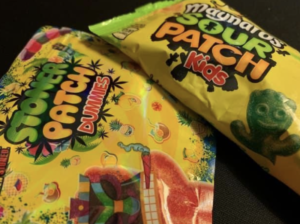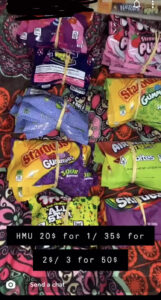What’s in your weed candies?

Fake marijuana edibles resembling popular candies such as Sour Patch, Starburst, and Nerds have popped up on Castleton University campus in recent months, mimicking a massive boom in these counterfeit products across the United States.
Often packaged under monikers like “Medicated Starbursts,” “Stoner Patch,” and “Infused Gushers,” the candies have sparked a larger investigation into the world of black market THC products.
In 2019, vaping and the supposed issues it caused took U.S. media by storm. According to the CDC, within a year a total of 2,711 hospitalizations led to serious, and occasionally fatal, lung injuries.
Today, black market THC and nicotine products can be easily found with a quick Google search or the click of a ‘send message’ button, with both small time and larger dealers distributing the colorful edibles.
Ready-to-seal product bags can be found in bulk online and, according to investigative journalist Zachary Harris at Complex Magazine, “all dealers need to do is unwrap bulk quantities of real Nerds Rope or Sour Patch candies, spray them with cheap THC distillate, and repackage them in the pre-labeled edible bags.”
In most cases, Harris wrote, the distillate used is chemically identical to the illicit products used in the counterfeit vape cartridges that dominated headlines in 2019. It is unlikely these tainted edibles could result in a health crisis as severe as those caused by inhaled products, but the potentially unsafe manufacturing and varying potency could lead to a host of other problems—including improper usage, possible toxic contamination, and short-term digestive issues.
An CU student buyer we’ll call Jane Doe-A, frequently uses THC products and says that, though there aren’t many dealers readily available on-campus, she’s seen these synthetic edibles more than ever before around the school.
“It’s really hard because you’re getting charged a lot for these ‘dank’ edibles and I feel no higher than I did before I ate them. I don’t trust any of those parodies anymore. My roommate is selling them and she tries to talk them up, but I know they’re bunk,” she said. “Personally, I worry that the game of running bunk edibles and dab carts that are cheaply made is gonna affect how we get good, reliable weed.”
Often cut with pesticides, chemicals, and unknown substances when mass produced, Doe-A says the packaging is an unreliable measure of what’s in the bag. Most of these products tout a whopping 400-600mg of THC in each with anywhere from 30-60mg per piece, however often times, the numbers simply don’t add up.
“The bag will say starbursts 500mg, 30mg a piece, and you open the bag and there’s only six pieces. So only, what, 180mg total? Not even close to 500mg,” Doe-A said.

In states where recreational marijuana has been legalized, dispensaries and other cannabis sellers are regulated to 10mg of THC per piece of candy—and many have turned to something they believe will give them a better high.
“I bought them once through a friend from some freshman dealer, but it was totally a scam. I smoke [pot] pretty regularly and I calculated that each time I do, I’m inhaling roughly 10mg worth of THC—and keep in mind, not all of that will be absorbed. Just one 30mg candy should’ve knocked me on my ass—and I ate the whole bag,” said off-campus student Jane Doe-B.
In September of 2020, a research facility in South Long Beach, Calif. was requested by an anonymous client to analyze nine “Medicated Nerds Ropes.” The facility, BelCosta Labs, determined each of the nine ropes contained less than 10mg of THC and trace amounts of foreign materials—though it wasn’t stated what those foreign materials were. The results of these tests were ultimately posted for public viewing by Blacklist.xyz–a highly-regarded online platform for all things cannabis, known for its honest and critical viewpoint, and its support for smaller non-corporate dispensaries.
BelCosta Labs announced that though the tested batch wasn’t likely to cause any issues for individuals of age to consume, the wide variety of individual sellers means that this round of testing likely only applies to a select number of products on the market.
Other batches, produced by more unscrupulous dealers, could be cut with any cheap material that is soluble in the THC distillate—including pesticides, various oils such as MCT and vitamin E, or even more harmful substances like motor and vegetable oil. According to a commenter on the popular THC discussion forum, “Future4200,” “If it dispels, it sells.”
An ultimately expected consequence of this boom in black market THC candy sales has been the harm to unknowing children across the United States.
Two children in Roy, Utah were hospitalized. Another was hospitalized in St. Johns County, Florida and three more in Cleveland, Ohio. There were others in Massachusetts, Pennsylvania, South Dakota and New Jersey. A quick Google search lists article after article of these eerily identical edibles being consumed by children.
Advocates and protesters alike have called on THC producers to create more child-proof and child-resistant packaging, but the unregulated underbelly of this market is unlikely to listen.
Though many are already convinced when they see a sealed, professionally packaged bag, it is nearly impossible to determine which of these branded edibles have been tainted. In an age of thousands of black-market look-alikes, student Jane Doe-A urges her peers to be cautious about what’s in their weed products.
“The ones around here won’t get you high and dealers can shortbag and charge the same amount because the word ‘Skittles’ or ‘Nerds’ is on the label,” Doe-A said. “It’s just not worth it.”







